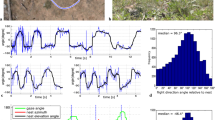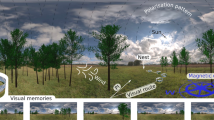Abstract
In order to analyse how landmarks guide the last stages of an insect's approach to a goal, we recorded many flights of individual wasps and honeybees as they flew to an inconspicuous feeder on the ground that was marked by one or by two nearby landmarks. An individual tends to approach the feeder from a constant direction, flying close to the ground. Its body is oriented in roughly the same horizontal direction during the approach so that the feeder and landmarks are viewed over a narrow range of directions. Consequently, when the insect arrives at the feeder, the landmarks take up a standard position on the retina. Three navigational strategies govern the final approach. The insect first aims at a landmark, treating it as a beacon. Secondly, bees learn the appearance of a landmark with frontal retina and they associate with this stored view a motor trajectory which brings them from the landmark sufficiently close to the goal that it can be reached by image matching. Insects then move so as to put the landmark in its standard retinal position. Image matching is shown to be accomplished by a control system which has as set points the standard retinal position of the landmark and some parameter related to its retinal size.
Similar content being viewed by others
Author information
Authors and Affiliations
Additional information
Accepted: 1 March 1997
Rights and permissions
About this article
Cite this article
Collett, T., Rees, J. View-based navigation in Hymenoptera: multiple strategies of landmark guidance in the approach to a feeder. J Comp Physiol A 181, 47–58 (1997). https://doi.org/10.1007/s003590050092
Issue Date:
DOI: https://doi.org/10.1007/s003590050092




